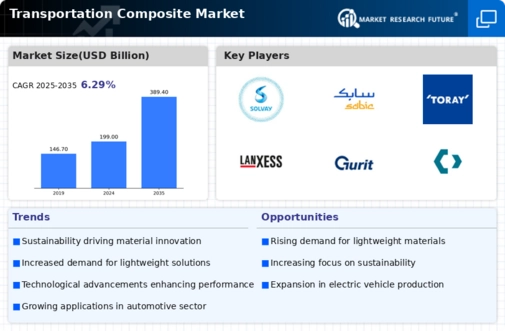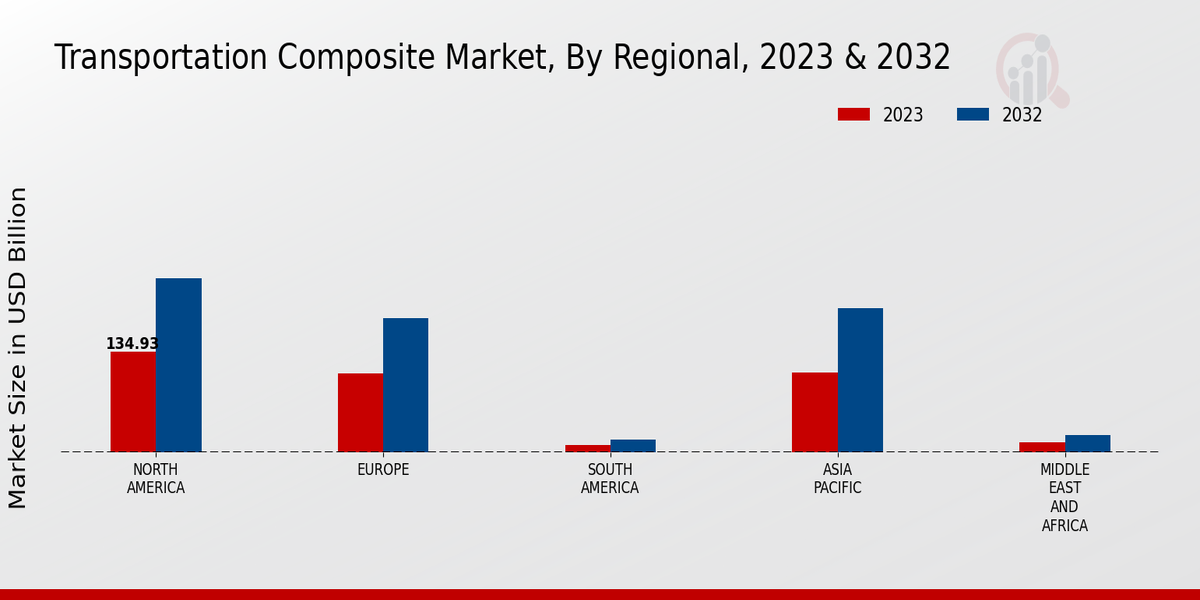Market Growth Projections
The Global Transportation Composite Market Industry is projected to witness substantial growth in the coming years. With a market value of 199 USD Billion in 2024, the industry is on a trajectory towards reaching 389.4 USD Billion by 2035. This growth is indicative of the increasing adoption of composite materials across various transportation sectors, including automotive, aerospace, and marine. The anticipated CAGR of 6.29% from 2025 to 2035 further emphasizes the market's potential, driven by technological advancements, regulatory support, and the rising demand for sustainable practices. These projections highlight the dynamic nature of the industry and its capacity for innovation.
Increasing Investment in R&D
Increasing investment in research and development is a key driver for the Global Transportation Composite Market Industry. Companies are allocating substantial resources to innovate and enhance composite materials, focusing on improving performance, durability, and cost-effectiveness. This investment is crucial for developing next-generation composites that meet the rigorous demands of the transportation sector. Collaborative efforts between industry players and research institutions are fostering breakthroughs in material science. As a result, the market is anticipated to grow from 199 USD Billion in 2024 to 389.4 USD Billion by 2035, reflecting the impact of sustained R&D efforts on market expansion.
Growing Demand for Lightweight Materials
The Global Transportation Composite Market Industry experiences a growing demand for lightweight materials, driven by the need for fuel efficiency and reduced emissions. Composites, such as carbon fiber and fiberglass, are increasingly utilized in automotive, aerospace, and marine applications. These materials not only enhance performance but also contribute to sustainability goals. As of 2024, the market is valued at 199 USD Billion, reflecting a significant shift towards innovative materials. This trend is expected to continue, with projections indicating a market value of 389.4 USD Billion by 2035, suggesting a robust growth trajectory fueled by advancements in composite technology.
Technological Advancements in Manufacturing
Technological advancements in manufacturing processes are pivotal in shaping the Global Transportation Composite Market Industry. Innovations such as automated fiber placement and 3D printing are enhancing production efficiency and reducing costs. These technologies enable manufacturers to produce complex composite structures with precision, catering to the evolving demands of the transportation sector. The integration of smart manufacturing techniques further streamlines operations, potentially increasing output and quality. As the industry adapts to these advancements, the market is poised for substantial growth, with a projected CAGR of 6.29% from 2025 to 2035, indicating a promising future for composite materials.
Regulatory Support for Sustainable Practices
Regulatory support for sustainable practices plays a crucial role in the Global Transportation Composite Market Industry. Governments worldwide are implementing stringent regulations aimed at reducing carbon footprints and promoting environmentally friendly materials. This regulatory landscape encourages manufacturers to adopt composites that align with sustainability goals, thereby enhancing their market competitiveness. For instance, initiatives promoting electric vehicles and lightweight structures are driving the demand for advanced composites. As the industry responds to these regulations, the market is expected to expand significantly, with a forecasted value of 389.4 USD Billion by 2035, highlighting the importance of compliance in driving growth.
Expansion of Electric and Autonomous Vehicles
The expansion of electric and autonomous vehicles significantly influences the Global Transportation Composite Market Industry. As the automotive sector shifts towards electrification and automation, there is an increasing need for lightweight and high-performance materials that enhance vehicle efficiency and safety. Composites are integral to the design of these vehicles, providing the necessary strength while minimizing weight. This trend is expected to drive substantial growth in the market, with projections indicating a CAGR of 6.29% from 2025 to 2035. The ongoing evolution of vehicle technology underscores the critical role of composites in shaping the future of transportation.












